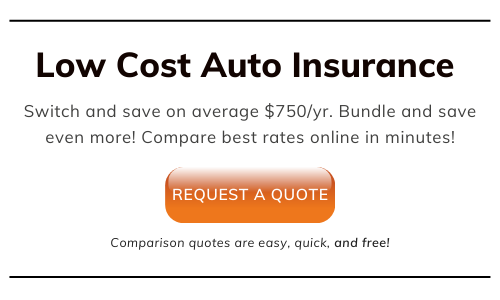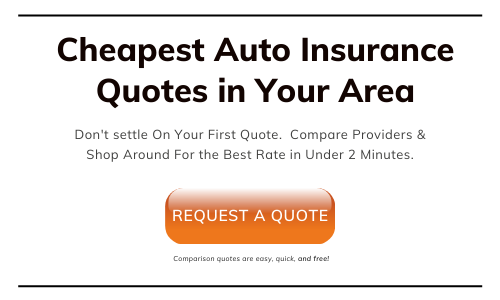Here’s Why Your Car Insurance Is So High
Having car insurance is required in all states except New Hampshire, which has no mandatory insurance law, and Virginia, where you can pay an annual fee to the DMV instead of purchasing insurance.
The minimum amount of insurance coverage required and the actual cost of an insurance policy varies by state.
However, even in states that traditionally have lower rates, you may still be asking yourself, “Why is my car insurance so high?”
If you believe your insurance is too high, you might want to do a little background research.
Insurance providers calculate insurance premiums based on risk.
While your geographic location is a key factor, there are numerous other elements they use to determine the overall risk of insuring you.
This guide explains how each one affects your car insurance premium, providing valuable insight into how you can then lower your costs.
What Can Cause Your Car Insurance To Go Up In The First Place?
There are several main criteria every insurer sticks with (these are pretty much uniform requirements from all carriers):
Personal Details
Car insurance carriers use statistical information to determine coverage rates based on demographics, such as age, gender, and marital status.
- Teen drivers traditionally see higher rates than any other age group due to inexperience and a tendency to engage in risky behavior behind the wheel.
- Male drivers also see higher rates, as statistics show that more men die in motor vehicle crashes, typically drive more miles, and engage in riskier driving practices than women. Married couples generally pay less than single drivers.
Place of Residence
Because state minimum car insurance requirements vary, where you live has a significant impact on your insurance rate.
Many states require a set amount of bodily injury and property damage liability insurance, and higher required amounts usually increase your insurance premium.
Other states also require personal injury protection or uninsured/underinsured motorist coverage, which hikes up your premiums even more.
Drivers who live in urban areas with high population and traffic densities pay more than those in rural areas.
The logic is that the more people and traffic on the road, the higher the odds that accidents may occur.
Driving Patterns
From a risk perspective, the more miles you drive, the higher the probability of having an accident.
This increased risk translates to higher insurance rates. Your rates can rise even more if you use your vehicle for business purposes, such as providing ride sharing or delivery services.
Carpooling to work or using public transportation lowers your mileage, so inform your insurance provider of your commuting habits.
Your Policy
As a consumer, you have limited control over what type of coverage is included in your policy, since its necessary to carry the mandatory minimum required in your state. If you don’t own your vehicle, the lien holder requires comprehensive and collision coverage.
You can control your deductible amounts, however—the lower your deductible, the higher your insurance, and vice versa. (For more information, read our “What is a car insurance deductible, and how does it work?“).
Just make sure you have the wherewithal to pay your out-of-pocket costs should an accident occur. You also have control over optional coverages such as roadside assistance, windshield, and sound system.
However, the more items you add on, the more expensive your policy is.
Your Car
Vehicle choice affects your rate in multiple ways. An expensive, high-performance sports car costs more to insure than a sensible family car.
Providers believe that sports cars invite risky driving behavior and these types of vehicles typically cost more to repair.
Cars with higher safety ratings and factory-installed safety devices usually have lower rates. If you live somewhere with a high incidence of vehicle theft, you could also see higher prices if you choose a vehicle commonly stolen in your area.
Credit History
Most car insurance providers use your credit history as a significant factor in determining your level of risk.
A poor credit score can cost you, but even drivers with good scores can pay an average of $68 to $526 more per year compared to drivers with the best scores.
In some states, your credit score has more of an impact on your premium than any other factor. Only California, Hawaii, and Massachusetts prohibit insurers from using credit scores to determine your premium.
Driving Record
Tickets and accidents stay on your record for years, but the exact length of time varies by state. A history of accidents or tickets can have a massive impact on your premium.
Insurance providers may consider you a higher risk to insure and raise your premium, even if an infraction occurred some time ago.
Are Your Car Insurance Premiums Really So High, Anyway?

Car insurance rates have been getting progressively higher each year, so it’s vital to understand average car insurance rates and what causes these to increase.
DMV.org compiled averages for four states using a variety of scenarios for each to demonstrate how much average rates can differ.
They calculated these averages based on the premium rates of numerous car insurance companies as reported to each of the state’s insurance departments.
California
Using the California Department of Insurance comparison tool, DMV.org calculated the state’s average car insurance premium for basic liability for:
- A single female with 9-15 years of driving experience, one traffic violation, and a reported 12,000 to 15,000 miles driven annually at $927.29.
- A single male in the same scenario at $929.74.
- A married couple with one traffic violation who drive approximately 12,000 to 15,000 miles annually at $1,423.69.
Florida
Using the Florida Office of Insurance Regulation’s auto rate comparison tool, DMV.org calculated the state’s average car insurance premium for a policy covering the minimum requirements for:
- A single female who’s 25 and has one traffic violation, one no-fault accident, and a reported 12,000 miles driven annually at $1,364.72.
- A married couple, both age 50, with two children aged 18 and 20 at $3,027.23.
Texas
Using the Texas Department of Insurance’s sample premium rate tool, DMV.org calculated the state’s average car insurance premium for a policy covering the minimum requirements for:
- A single male age 25-64 who primarily uses his vehicle to drive to and from work with one traffic violation and an average credit rating at $888.50.
- A single female in the same scenario at $838.75.
Massachusetts
Using comparisons from Massachusetts’ Division of Insurance auto insurance premium comparisons, DMV.org calculated the state’s average car insurance premium for:
- A single driver licensed for 14 years insuring a 2008 sedan with the minimum state requirements at $600.58.
- A married couple, one licensed for 14 years and the other for 12, with one traffic violation and one accident between them, insuring two vehicles with comprehensive coverage and higher-than-required liability coverage at $1,667.31.
When you’re trying to lower your insurance premium, there are many things outside your control.
You can’t instantaneously make yourself older, erase a lousy driving record, or increase a poor credit rating.
Nor would you move to another city or state just because your car insurance is high.
The good news is that there are still several, less drastic ways to decrease the cost of your car insurance.
5 Things You Can Do to Lower Your Premiums
Here’s a quick list of things you can do to lower your rates if you think your rates are a bit too excessive”
1. Compare Insurance Costs Before Buying a Car
Before buying a car, compare coverage to find out what it’s going to cost to insure it.
Get sample quotes online or provide your agent or broker with the potential vehicle’s information to ascertain if its insurance cost is within your budget.
Premiums are based on several factors, including the vehicle’s price, average repair costs, overall safety record, and likelihood of being stolen.
More expensive cars have higher premiums because they can cost more to repair or replace if you have an accident.
2. Take Advantage of Discounts
Discounts are the quickest, easiest ways to lower your insurance costs. Insurance providers offer a wide variety of discounts, some more than others. When comparison shopping, ask about some of these discounts.
- Safe/Good driver: Regardless of what the provider calls it, this discount rewards a driver with a clean driving record.
- Good student: Discounts may be offered for teen drivers with good grades. Teens can also lower their insurance by taking driver’s education courses.
- Low mileage: Some insurance providers have a mileage cap, so drivers who don’t drive much could qualify for a low mileage discount. Having a short daily commute to work or only driving a few days each week could help you earn this discount.
- Security devices: Anti-theft devices, such as car alarms, and stolen vehicle recovery systems, such as OnStar, Allstar, or LoJack systems, sometimes earn discounts, especially in areas with high auto theft rates.
- Safety devices: Many insurance providers offer discounts for proven safety devices, such as air bags, electronic stability control, anti-lock brakes, and passive restraints. Advanced safety devices like rear-view cameras, lane departure warnings, and automatic emergency braking, are still considered unproven, so few providers currently offer discounts for these devices.
- Alternative fuel: You may earn a discount for vehicles that use eco-friendly fuel systems, such as hybrid, electric, ethanol, or flex-fuel vehicles.
- Vehicle type: Certain types of vehicles sometimes have their own special discounts. These include economy cars, utility vehicles, and farm or ranch vehicles.
- Affinity groups: If you’re a teacher, doctor, lawyer, or other professional, you may enjoy discounts specifically for you. Veterans, seniors, and retirees may also qualify for discounts.
- Payment arrangements: If you set up auto-pay, pay your bill in full, or renew in advance, you could earn a discount. Some insurance providers also offer loyalty discounts for long-term customers and discounts for using their telematic devices.
These are some of the many discounts that may be available to you. Not all discounts are available in every state or with every insurance provider, but always ask to make sure you’re getting everything you qualify for.
3. Engage in Bundling
Bundling policies is another type of discount. You can bundle multiple automobiles with the same insurance provider to earn a multi-vehicle discount.
However, you often gain bigger savings by bundling multiple types of policies.
Earn a multi-policy discount by bundling your renter’s or homeowner’s insurance with your car insurance, or bundle your motorcycle, boat, motor home, or other recreational vehicles with the same provider to qualify for other multi-policy discounts.
The more you bundle, the more you save, most of the time.
4. Select a Higher Deductible
If you have caught yourself frequently grumbling, “Why is my car insurance so high?” maybe you should look at your deductible limits.
Your deductible comes into play on comprehensive and collision coverage. It’s the amount you’re responsible for paying before the insurance company kicks in for repair costs.
By choosing a higher deductible, you could substantially lower your costs.
However, be sure you have enough money set aside to cover the deductible should you have an accident that requires a claim.
5. Shop Different Insurance Companies
Insurance costs vary from one provider to another, so it pays to shop around.
Always get at least three insurance quotes from different providers.
However, don’t shop for price alone.
Compare coverage to make sure each policy offers the same amount and type of coverage to determine whether a lower priced option actually provides the best deal. Begin your search by browsing the list of top 10 auto insurance providers.





